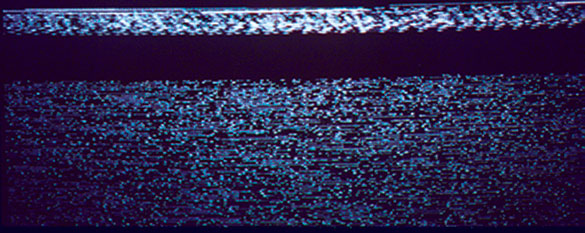CD in digipak – 2 tracks – 48:20
Art Direction: Jon Wozencroft
Cover image: Yusuke Murakami
Track listing:
1. Midnight at the Oasis 28:03
2. The Bee Symphony 20:00
Notes:
Midnight at the Oasis: – The piece is a 28 minute time compression from sunset to sunrise in South Africa’s Kalahari desert and features the dense and harmonic mosaic of delicate animal rhythms recorded in this remote habitat. “Midnight at the Oasis” was first performed at the Marquee in Parliament Street, York, on 13th September 2007 as part of Sight Sonic.
“The Kalahari desert is a vast and open space where most of the wildlife is nocturnal. After sunset the dunes, grasses and thorn bushes are patrolled by an emerging alien empire – the insects.
Midnight at the Oasis’ presents an unseen soundscape from this beautiful and hostile environment.
The Bee Symphony: A project conceived by Chris Watson originally for “Pestival” in 2009 to explore the vocal harmonies between humans and honey bees in a unique choral collaboration around and within the hives of an English country garden. Recorded live at The Rymer Auditorium, Music Research Centre, University of York, England on December 17th 2010 by Tony Myatt, using a Soundfield SPS200 microphone recorded onto an Edirol R4 (surround version), and 2 x Neumann U87 microphones via Grace Microphone Preamplifiers, recorded onto an Edirol R44 (stereo version). Composed and arranged by Marcus Davidson using recordings made by Chris Watson & Mike Harding, and diffused through a 4.1 Genelec system by Chris Watson. The Bee Choir: Dylan de Buitlear, Lisa Coates, Steph Connor, Lewis Marlowe and Shendie McMath. With thanks to Peter Boardman (the event producer), Tom Emmett, Celia Frisby & Bridget Nicholls, who originally commissioned The Bee Symphony.
Marcus Davidson writes: “The first thing that struck me about the bees was how tuneful they were. During the day, their pitch was always based around A an octave below 440, the note we tune orchestras to. I found that the bees formed chords around the A, which varied depending on their mood. I spent time notating these bee chords, or note clusters, and as the bees sing easily in the human vocal range, I then scored the actual bee music for choir.
The sound of humans singing bees was strangely engaging. I thought it was reminiscent of Aboriginal music, perhaps showing how in tune with nature the native civilisations are. In fact, all the chords and ‘tunes’ in The Bee Symphony are taken from actual notes sung by the bees in the field recordings. The score was written so the choir sings exactly with different aspects of the bee song in real time, so hopefully we indeed have humans singing in harmony with bees!”
For further information, visit The Bee Symphony microsite











